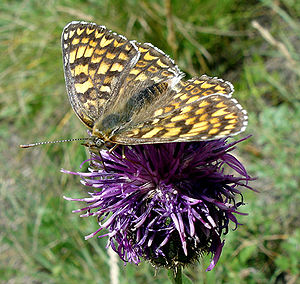Knapweed pied butterfly
| Knapweed pied butterfly | ||||||||||||
|---|---|---|---|---|---|---|---|---|---|---|---|---|

Knapweed butterfly ( Melitaea phoebe ) |
||||||||||||
| Systematics | ||||||||||||
|
||||||||||||
| Scientific name | ||||||||||||
| Melitaea phoebe | ||||||||||||
| ( Denis & Schiffermüller , 1775) |
The knapweed piebald butterfly ( Melitaea phoebe ) is a butterfly (day butterfly ) from the noble butterfly family (Nymphalidae).
features
The moths reach a wingspan of 32 to 42 millimeters. Depending on the animal, their wing tops are patterned dark to lighter brown and orange. The dark spots on the edge of the hind wings, as found in other pied butterflies, are missing . The rest of the pattern is very similar. A special distinguishing feature of this species is one of the orange sickle spots that line the edge of the wing, which protrudes significantly further into the center of the wing than the others. The undersides of the hind wings are mostly divided into white, black-bordered fields, but between them run in two rows of orange spots arranged more or less like a bandage. The undersides of the forewings are more orange, but the outer wing tip is just as bright as the hind wings.
The caterpillars are about 30 millimeters long. They are colored black-gray with more or less numerous white dots and have orange-red side bands on the lower sides. They also have orange to brown, cone-shaped thorns.
Similar species
- Plantain-Scheckenfalter ( Melitaea cinxia )
- Melitaea trivia
- Red moth ( Melitaea didyma )
Flight times
The animals usually fly in two generations from mid-April to mid-June and from late June to early September.
Occurrence
The animals occur in North Africa , Europe to the north, the Middle East , Turkey , in Central Asia to the north of China . In Europe they occur up to 1,900 m above sea level, in North Africa even up to 2,700 m. They live in warm and dry areas, especially on tall, poor grasslands . In Central Europe they are common in warm places in the mountains , but their populations are in decline almost everywhere.
Food of the caterpillars
The caterpillars feed on meadow knapweed ( Centaurea jacea ), pigeon scabies ( Scabiosa columbaria ), common thistle ( Cirsium vulgare ) and other herbaceous plants.
development
The young caterpillars live together in webs on the forage plants. They hibernate and will need until summer to pupate next year.
Hazard and protection
- Red list FRG: 2 (endangered)
swell
Individual evidence
- ↑ a b c d e f Heiko Bellmann : The new Kosmos butterfly guide. Butterflies, caterpillars and forage plants. Franckh-Kosmos, Stuttgart 2003, ISBN 3-440-09330-1 , p. 184.
- ↑ http://schmetterling-raupe.de/art/phoebe.htm
- ↑ a b Tom Tolman, Richard Lewington: The butterflies of Europe and North West Africa , p. 166, Franckh-Kosmos Verlags-GmbH & Co, Stuttgart 1998, ISBN 3-440-07573-7
- ↑ Federal Agency for Nature Conservation (Ed.): Red List of Endangered Animals in Germany. Landwirtschaftsverlag, Münster 1998, ISBN 3-89624-110-9
Web links
- Lepiforum e. V. Photos and taxonomy
- www.schmetterling-raupe.de
- Moths and Butterflies of Europe and North Africa (English)
- Melitaea phoebe at Fauna Europaea



